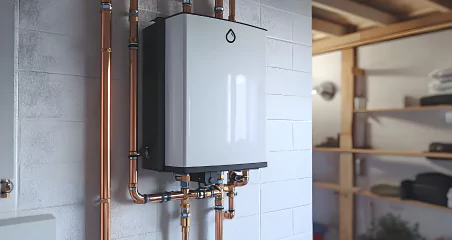Getting a new water heater might seem straightforward—just pick one, install it, and enjoy warm showers. However, the process is more complex than it appears at first glance. Whether you’re replacing an aging unit or upgrading to a more energy-efficient model, there are numerous details that many homeowners overlook. Understanding these hidden factors before installation can help you avoid unexpected costs, installation hurdles, and future headaches. Let’s explore everything you need to consider when getting a new water heater.
Choosing the Right Type
Not all water heaters are created equal. Before purchasing a new unit, it’s essential to evaluate different types to determine which best suits your household’s needs. Here are some key factors to consider:
Tank vs. Tankless
Traditional tank water heaters store heated water in a large reservoir, ensuring a constant supply but also leading to standby energy loss. In contrast, tankless models heat water only when needed, which can save energy and reduce utility bills over time. While tankless units have a higher initial cost, they take up less space and can last longer than traditional tanks.
Gas vs. Electric
Gas water heaters typically heat water more quickly and have lower operational costs than electric models. However, they require proper ventilation and may necessitate additional gas line installations. Electric water heaters, on the other hand, are often easier to install, require less maintenance, and can be more energy-efficient in certain settings, especially when paired with solar power.
Capacity Matters
Choosing the right size is crucial to ensure your household has a sufficient supply of hot water. A typical family of four requires at least a 50-gallon tank to meet daily demands. For tankless water heaters, sizing depends on simultaneous water usage—if multiple showers or appliances are running at once, you’ll need a model with a higher flow rate.
Hidden Installation Costs
The price of the water heater itself is just one part of the total cost. Many homeowners forget to factor in the various additional expenses associated with installation. These can include:
Permits & Inspections
In many areas, installing a new water heater requires permits to comply with building codes. Depending on your location, inspection fees may also be necessary, adding to the overall cost.
Upgrading Gas Lines or Electrical Wiring
If you’re switching from electric to gas or vice versa, modifications to your home’s infrastructure may be needed. Even if you’re staying with the same type of heater, an upgrade to a more powerful model might require adjustments to gas lines, electrical wiring, or circuit breakers, leading to extra expenses.
Expansion Tanks
If your home has a closed plumbing system, an expansion tank may be required. This helps absorb pressure changes in the water heater, preventing potential damage to pipes and fixtures.
Placement & Space Considerations
Many homeowners assume their new water heater will fit exactly where the old one was. However, newer models are often larger due to updated energy efficiency standards, which can create installation challenges.
Larger Units
Enhanced insulation and safety features make some modern water heaters bulkier. If your previous model was compact, you may need to allocate more space or adjust the installation area.
Ventilation Needs
Gas water heaters require proper ventilation to safely expel exhaust gases. Upgrading to a more powerful unit may necessitate additional ventilation modifications, such as installing a new venting system or increasing airflow clearance.
Accessibility for Maintenance
Your new water heater should be installed in an area where it can be easily accessed for repairs, draining, or future replacements. Cramped spaces or hard-to-reach locations can make routine maintenance more challenging and expensive.
Energy Efficiency & Long-Term Savings
While high-efficiency water heaters tend to have a higher initial cost, they can save you money in the long run by reducing energy consumption. Here’s how:
Energy Star Models
Water heaters with the Energy Star label meet strict efficiency guidelines, using less power while delivering the same performance as standard models. This results in lower utility bills over time.
Better Insulation
Newer tank-style water heaters feature improved insulation to reduce standby heat loss. This means less energy is needed to maintain hot water temperature, lowering operational costs.
Rebates & Tax Credits
Some energy-efficient water heaters qualify for government rebates or tax credits, helping to offset the upfront cost. Check with your local energy provider or government incentives program to see if you’re eligible.
Installation Time & Disruptions
Replacing a water heater isn’t always a quick and easy process. Unexpected complications can extend the installation timeline, leading to temporary water outages and additional labor costs.
Old Unit Removal
Draining and removing an old water heater can take longer than expected, especially if it’s located in a cramped space or has corroded connections. Proper disposal of the old unit may also incur extra fees.
Plumbing Adjustments
Water heater connections may not always align perfectly, requiring modifications to your home’s plumbing system. This could involve replacing fittings, rerouting pipes, or installing additional components to ensure compatibility with the new unit.
Water Downtime
During installation, your household may be without hot water for several hours. If additional work is needed, such as upgrading gas lines or rewiring electrical connections, the downtime could be even longer. Planning for this disruption by scheduling installation at a convenient time is advisable.
Final Thoughts
Installing a new hot water heater involves far more than simply picking a unit and plugging it in. From hidden costs and space limitations to energy efficiency and long-term savings, careful planning is essential to ensure a smooth installation process. Understanding these factors ahead of time can help you make an informed decision and avoid unexpected surprises. Whether you choose a gas or electric model, tank or tankless design, taking these considerations into account will help you get the most out of your investment, ensuring a reliable and efficient hot water supply for years to come.





